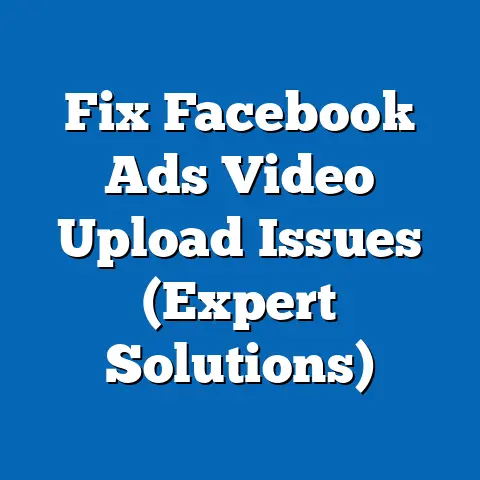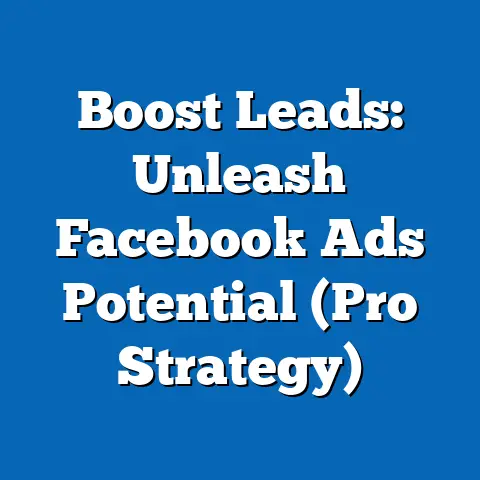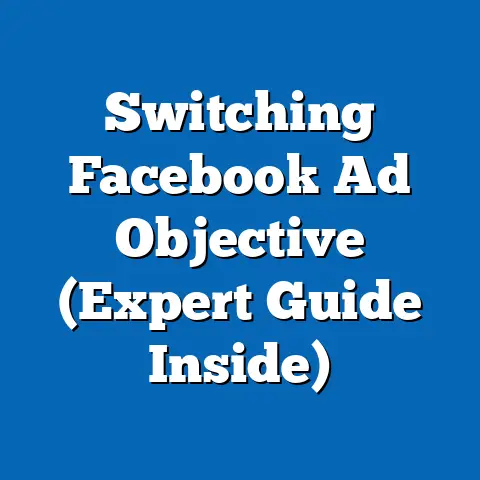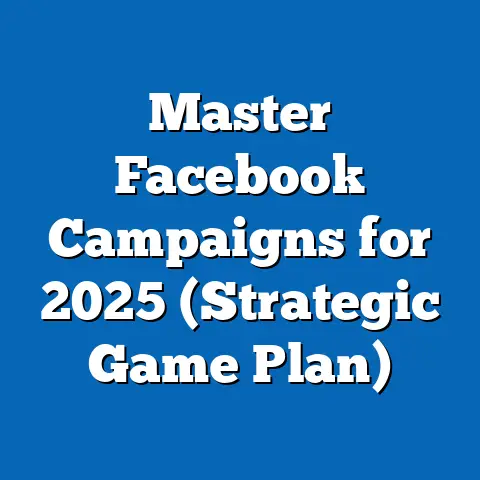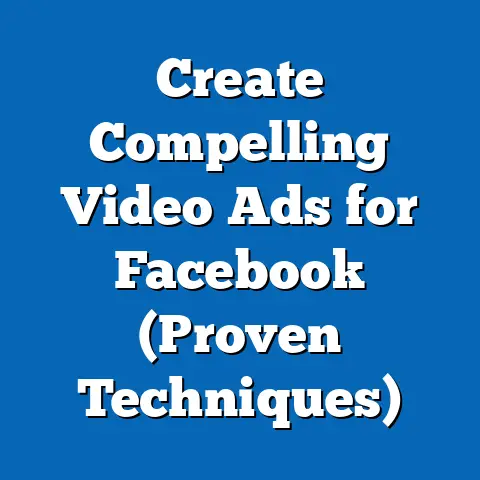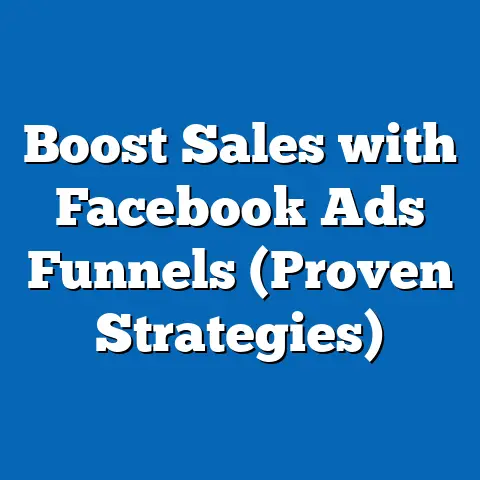Maximize CPM for Facebook Ads 2025 (Proven Strategies)
The Facebook advertising landscape in 2025 is a battlefield. If you’re not constantly adapting, you’re likely throwing money into a black hole. The competition is fierce, and consumers are savvier than ever. Failing to optimize your CPM (Cost Per Mille, or cost per thousand impressions) can be the difference between a thriving campaign and a disastrous waste of your advertising budget. I’ve seen countless businesses, big and small, crumble under the weight of inefficient ad spend. This isn’t just about saving money; it’s about maximizing your reach, engagement, and ultimately, your conversions.
In this guide, I’ll walk you through not only the fundamental understanding of CPM but also the advanced techniques that will help you dominate the Facebook advertising game in 2025. We’ll dive deep into audience analysis, creative optimization, and leveraging Facebook’s powerful features. Get ready to transform your approach and make every dollar count.
Section 1: Understanding CPM and Its Importance
CPM, or Cost Per Mille, is the amount you pay for one thousand impressions of your ad on Facebook. It’s a core metric that differs significantly from other pricing models like CPC (Cost Per Click), where you pay only when someone clicks on your ad, and CPA (Cost Per Acquisition), where you pay only when a desired action (like a purchase) is completed.
Why is CPM so important?
- Measuring Ad Performance: CPM gives you a direct view of how much it costs to get your ad seen. A high CPM can indicate problems with your targeting, ad creative, or overall campaign setup.
- Budget and ROI: If your CPM is too high, you’re effectively paying more for each potential customer to simply see your ad. This eats into your budget and lowers your return on investment (ROI). I remember working with a client in the e-commerce space whose CPM was through the roof. After digging in, we discovered their targeting was too broad, and their ad creative wasn’t resonating with the audience. We tightened the targeting and revamped the creative, and their CPM plummeted, leading to a significant increase in sales.
- Benchmarking: Monitoring your CPM allows you to benchmark against industry averages and track your own progress over time.
CPM in 2025:
According to recent reports, CPM rates on Facebook have continued to climb in 2025, increasing by approximately 15-20% year-over-year in many industries. This is due to increased competition, platform saturation, and evolving ad algorithms. What does this mean for you? It means you have to be smarter and more strategic than ever. The days of simply throwing money at Facebook and hoping for the best are long gone.
Key Takeaway: CPM is a critical metric for measuring ad performance and optimizing your advertising budget. In 2025, with rising CPM rates, understanding and managing this metric is more crucial than ever.
Section 2: Analyze Your Target Audience
In 2025, understanding your target audience is more than just knowing their age and location. It’s about understanding their intent, their behaviors, and their motivations. This requires a deep dive into data and a strategic approach to audience segmentation.
Strategies for Effective Audience Analysis:
- Facebook Audience Insights: This tool remains a valuable resource for understanding the demographics, interests, and behaviors of people connected to your Facebook page or those in your custom audiences. I use Audience Insights to get a granular view of my audience, uncovering hidden interests and potential targeting opportunities.
- Third-Party Analytics Platforms: Tools like Google Analytics, Mixpanel, and Amplitude can provide valuable insights into website visitors and customer behavior. Integrate these platforms with your Facebook Ads Manager to create highly targeted custom audiences based on user actions on your website.
- Customer Surveys and Feedback: Don’t underestimate the power of directly asking your customers about their needs and preferences. Use surveys, polls, and feedback forms to gather qualitative data that can inform your audience segmentation strategy.
- A/B Testing Audience Segments: Create different ad sets targeting different audience segments and monitor their performance closely. This allows you to identify which segments are most responsive to your ads and adjust your targeting accordingly.
- Leveraging First-Party Data: Your own customer data is a goldmine. Upload customer lists to create custom audiences and then use Lookalike Audiences to find new customers who share similar characteristics.
Tailoring Ad Content:
The key to reducing CPM is relevance. The more relevant your ad is to your target audience, the higher your engagement rates will be, and the lower your CPM will be. This means crafting ad copy and visuals that speak directly to the needs and interests of each audience segment.
Example:
Let’s say you’re selling fitness equipment. Instead of running a generic ad targeting “fitness enthusiasts,” you could create separate ad sets for:
- Yoga practitioners: Ads featuring yoga mats, blocks, and straps with copy highlighting the benefits of yoga for flexibility and stress relief.
- Weightlifters: Ads featuring barbells, dumbbells, and weight plates with copy focusing on building strength and muscle mass.
- Cardio enthusiasts: Ads featuring treadmills, ellipticals, and exercise bikes with copy emphasizing the benefits of cardio for weight loss and cardiovascular health.
Key Takeaway: In 2025, effective audience analysis is crucial for creating highly targeted ad campaigns that resonate with specific audience segments. By tailoring your ad content to match the needs and interests of each segment, you can improve engagement and reduce your CPM.
Section 3: Optimize Ad Creative
Your ad creative is your first (and often only) chance to grab someone’s attention on Facebook. In a world of endless scrolling, your ad needs to be visually appealing, persuasive, and instantly relevant.
Proven Strategies for Compelling Ad Creatives:
- High-Quality Visuals: Use professional-quality images and videos that are clear, well-lit, and visually engaging. Avoid using stock photos that look generic or staged. I’ve found that user-generated content (UGC) often performs exceptionally well because it feels more authentic and relatable.
- Persuasive Copy: Your ad copy should be concise, compelling, and benefit-driven. Focus on solving your audience’s problems and highlighting the unique value proposition of your product or service. Use strong verbs, sensory language, and social proof to increase persuasiveness.
- Strong Calls to Action: Make it clear what you want your audience to do. Use clear and concise calls to action (CTAs) such as “Shop Now,” “Learn More,” “Sign Up,” or “Get Started.” Experiment with different CTAs to see which ones perform best.
- A/B Testing: Continuously test different ad creatives to see what resonates best with your audience. Test different headlines, images, videos, and CTAs. Use Facebook’s built-in A/B testing feature to track the performance of each variation.
- Mobile Optimization: Ensure your ad creative is optimized for mobile devices. Most Facebook users access the platform on their smartphones, so your ads need to look good and function properly on smaller screens.
Examples of Successful Ad Campaigns in 2025:
- Interactive Ads: In 2025, interactive ads are all the rage. I saw a campaign for a clothing brand that used a quiz to help users find their perfect style. The quiz was engaging, fun, and generated tons of leads.
- Augmented Reality (AR) Ads: AR ads allow users to virtually try on products or experience them in their own environment. This is particularly effective for products like makeup, clothing, and furniture.
- Personalized Video Ads: Personalized video ads use data to create customized videos that speak directly to each viewer. This can be as simple as including their name in the video or as complex as creating a video that highlights products they’ve previously viewed on your website.
Key Takeaway: Compelling ad creative is essential for driving clicks and conversions on Facebook. By using high-quality visuals, persuasive copy, strong calls to action, and continuously A/B testing your creatives, you can maximize your CPM and achieve better results from your ad campaigns.
Section 4: Leverage Facebook Ad Features
Facebook Ads Manager is a powerhouse of features designed to help you optimize your campaigns. In 2025, mastering these features is no longer optional; it’s a necessity.
Advanced Features and Tools for CPM Optimization:
- Dynamic Ads: Dynamic ads automatically show the most relevant products to each user based on their browsing history and interests. This is particularly effective for e-commerce businesses with large product catalogs. I’ve seen e-commerce clients increase their click-through rates (CTR) by as much as 50% using dynamic ads.
- Custom Audiences: Create custom audiences based on your website visitors, customer lists, email subscribers, and app users. This allows you to target your ads to people who are already familiar with your brand.
- Lookalike Audiences: Expand your reach by creating lookalike audiences based on your custom audiences. Facebook will identify users who share similar characteristics to your existing customers, allowing you to reach new potential customers who are likely to be interested in your products or services.
- Ad Placements: Choose the right ad placements for your campaigns. Facebook, Instagram, Audience Network, and Messenger each offer different opportunities for reaching your target audience. Test different placements to see which ones perform best for your specific campaigns.
- Campaign Budget Optimization (CBO): Let Facebook automatically optimize your budget across your ad sets to get the best results. CBO can be particularly effective for campaigns with multiple ad sets targeting different audience segments.
- Value Optimization: If your goal is to drive purchases or other high-value conversions, use value optimization to target users who are most likely to spend the most money.
Example:
Let’s say you’re running a campaign to promote a new online course. You could use the following features to optimize your CPM:
- Create a custom audience of people who have visited your website or signed up for your email list.
- Create a lookalike audience based on your custom audience to reach new potential students who share similar characteristics.
- Use dynamic ads to show different versions of your ad to different users based on their interests and browsing history.
- Test different ad placements to see which ones perform best for your campaign.
- Use campaign budget optimization to let Facebook automatically optimize your budget across your ad sets.
Key Takeaway: Facebook Ads Manager offers a wealth of features and tools that can help you optimize your CPM and achieve better results from your ad campaigns. By mastering these features and using them strategically, you can take your Facebook advertising to the next level.
Section 5: Monitor and Adjust Campaigns in Real-Time
In the fast-paced world of Facebook advertising, real-time monitoring and adjustments are crucial for maintaining optimal performance. You can’t just set it and forget it. You need to be constantly monitoring your campaigns and making data-driven adjustments to keep your CPM low and your ROI high.
Importance of Real-Time Monitoring:
- Identify Problems Early: Real-time monitoring allows you to identify problems early before they have a significant impact on your budget and performance.
- Make Data-Driven Decisions: Data is your best friend. Use real-time data to inform your decisions about targeting, creative, and bidding strategies.
- Stay Ahead of the Competition: The Facebook advertising landscape is constantly evolving. Real-time monitoring allows you to stay ahead of the competition and adapt to changes quickly.
Key Performance Indicators (KPIs) Related to CPM:
- Reach: The number of unique users who saw your ad.
- Impressions: The number of times your ad was displayed.
- Frequency: The average number of times each user saw your ad.
- Engagement Rate: The percentage of users who interacted with your ad (e.g., likes, comments, shares, clicks).
- Click-Through Rate (CTR): The percentage of users who clicked on your ad.
- Conversion Rate: The percentage of users who completed a desired action (e.g., purchase, sign-up).
Actionable Strategies for Data-Driven Adjustments:
- Adjust Targeting: If your CPM is too high, try narrowing your targeting or experimenting with different audience segments.
- Refresh Ad Creative: If your engagement rate is low, try refreshing your ad creative with new images, videos, or copy.
- Optimize Bidding Strategy: Experiment with different bidding strategies to see which ones perform best for your campaigns.
- Pause Underperforming Ads: If an ad is not performing well, don’t be afraid to pause it and focus on ads that are generating better results.
- Increase Budget for High-Performing Ads: If an ad is performing exceptionally well, consider increasing its budget to maximize its reach and impact.
Example:
Let’s say you’re running a campaign to promote a new product. You notice that your CPM is higher than usual, and your engagement rate is low. After analyzing the data, you discover that your ad is not resonating with a particular audience segment. You decide to narrow your targeting to focus on audience segments that are more responsive to your ad. You also refresh your ad creative with new images and copy that are more relevant to your target audience. After making these adjustments, you notice that your CPM decreases, and your engagement rate increases.
Key Takeaway: Real-time monitoring and data-driven adjustments are essential for optimizing your Facebook ad campaigns and maintaining a low CPM. By keeping a close eye on your KPIs and making adjustments on the fly, you can maximize your ROI and achieve better results from your ad campaigns.
Section 6: Future Trends to Watch
The world of Facebook advertising is constantly evolving. To stay ahead of the curve in 2025 and beyond, you need to be aware of emerging trends and technologies that could impact your CPM.
Upcoming Trends in Facebook Advertising:
- Artificial Intelligence (AI) and Machine Learning (ML): AI and ML are already playing a significant role in Facebook advertising, and their influence will only continue to grow. AI-powered tools can help you automate tasks, optimize targeting, and personalize ad creative. I anticipate seeing even more sophisticated AI-driven solutions that can predict user behavior and optimize ad placements in real-time.
- Virtual Reality (VR) and Augmented Reality (AR): VR and AR technologies are creating new opportunities for immersive advertising experiences. VR ads can transport users to virtual worlds where they can interact with your products or services. AR ads can overlay digital content onto the real world, allowing users to try on products or visualize them in their own environment.
- Voice Search Optimization: With the rise of voice assistants like Siri and Alexa, voice search optimization is becoming increasingly important. Optimize your ad copy and landing pages for voice search to reach users who are using voice commands to find products and services.
- Privacy-Focused Advertising: Consumers are becoming increasingly concerned about their privacy, and Facebook is responding with new privacy features and policies. Advertisers need to adapt to this new reality by focusing on privacy-focused advertising strategies that respect user privacy while still delivering effective results.
- The Metaverse: The metaverse is a virtual world where users can interact with each other and with digital objects. Facebook (Meta) is investing heavily in the metaverse, and it’s likely to become a significant advertising platform in the future.
Potential Shifts in Consumer Behavior:
- Increased Demand for Personalization: Consumers are demanding more personalized advertising experiences. They want to see ads that are relevant to their interests and needs.
- Growing Skepticism of Traditional Advertising: Consumers are becoming increasingly skeptical of traditional advertising. They’re more likely to trust recommendations from friends, family, and influencers.
- Shift Towards Mobile-First Experiences: Mobile devices are becoming the primary way that people access the internet. Advertisers need to prioritize mobile-first experiences to reach their target audience.
Key Takeaway: The future of Facebook advertising is dynamic and unpredictable. By staying informed about emerging trends and technologies, you can position yourself for success and maximize your CPM in the years to come.
Conclusion
Maximizing CPM on Facebook in 2025 requires a multifaceted approach. It’s not just about one trick or hack; it’s about understanding the core principles of advertising, leveraging Facebook’s powerful features, and continuously adapting to the ever-changing landscape. We’ve covered a lot of ground in this guide, from understanding the fundamentals of CPM to exploring advanced strategies for audience analysis, creative optimization, and real-time monitoring.
The key takeaway is this: continuous learning and adaptation are essential for success in the fast-paced world of Facebook advertising. Don’t be afraid to experiment with new strategies, test different approaches, and learn from your mistakes. By implementing the proven strategies discussed in this article, you can maximize your CPM and achieve better results from your ad campaigns in 2025 and beyond. Now, go out there and make every impression count!

